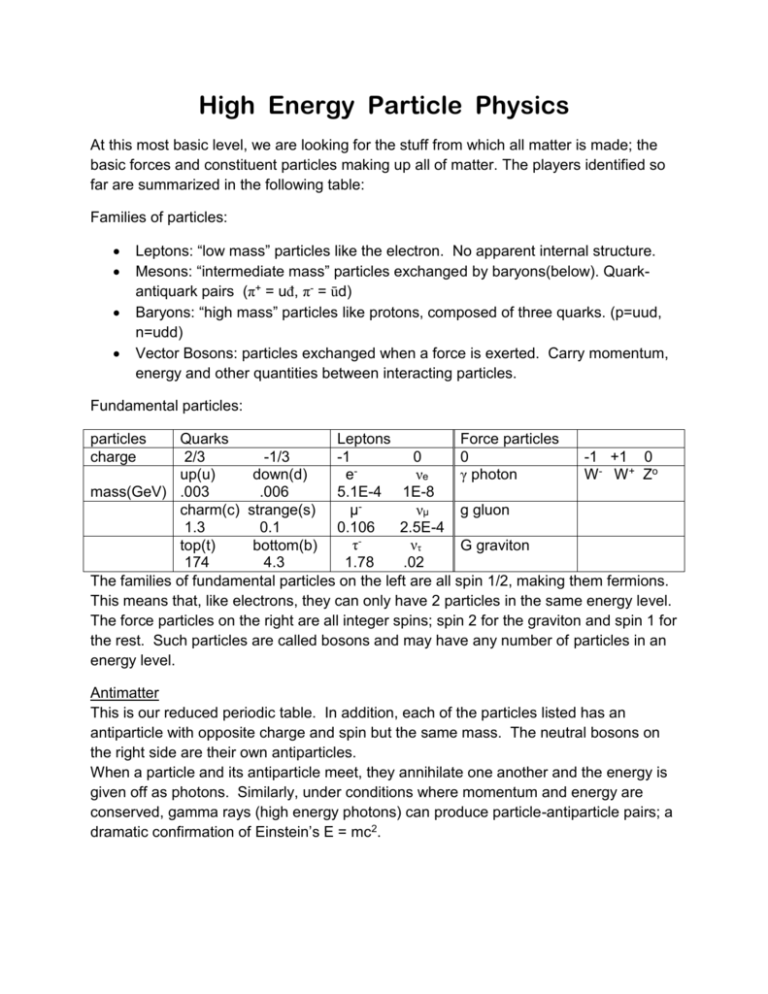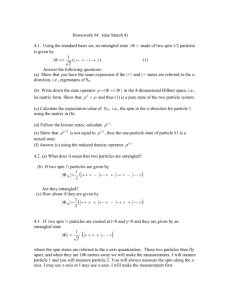High Energy Physics
advertisement

High Energy Particle Physics At this most basic level, we are looking for the stuff from which all matter is made; the basic forces and constituent particles making up all of matter. The players identified so far are summarized in the following table: Families of particles: Leptons: “low mass” particles like the electron. No apparent internal structure. Mesons: “intermediate mass” particles exchanged by baryons(below). Quarkantiquark pairs (π+ = uđ, π- = ūd) Baryons: “high mass” particles like protons, composed of three quarks. (p=uud, n=udd) Vector Bosons: particles exchanged when a force is exerted. Carry momentum, energy and other quantities between interacting particles. Fundamental particles: particles charge Quarks Leptons Force particles 2/3 -1/3 -1 0 0 -1 +1 0 eνe γ photon up(u) down(d) W- W + Zo mass(GeV) .003 .006 5.1E-4 1E-8 μνμ charm(c) strange(s) g gluon 1.3 0.1 0.106 2.5E-4 τντ top(t) bottom(b) G graviton 174 4.3 1.78 .02 The families of fundamental particles on the left are all spin 1/2, making them fermions. This means that, like electrons, they can only have 2 particles in the same energy level. The force particles on the right are all integer spins; spin 2 for the graviton and spin 1 for the rest. Such particles are called bosons and may have any number of particles in an energy level. Antimatter This is our reduced periodic table. In addition, each of the particles listed has an antiparticle with opposite charge and spin but the same mass. The neutral bosons on the right side are their own antiparticles. When a particle and its antiparticle meet, they annihilate one another and the energy is given off as photons. Similarly, under conditions where momentum and energy are conserved, gamma rays (high energy photons) can produce particle-antiparticle pairs; a dramatic confirmation of Einstein’s E = mc2. Forces are represented as the exchange of particles which carry momentum, energy and other quantities. It was found that two new forces were needed to represent nuclear interactions: the weak force responsible for beta decay and the strong nuclear force responsible for holding nuclei together (and ultimately to hold the quarks in the neutrons and protons themselves together). All the forces we have discussed and all those that physicists have investigated boil down to a total of four fundamental forces: gravity electromagnetic weak nuclear strong nuclear (Quantum Chromo Dynamics) For each force, there is a particle which is exchanged and certain combinations of particles which the particle can connect. These are easiest to represent in Feynman diagrams. Feynman diagrams display interactions of objects in a space-time plot. For example, the collision of two billiard balls can be diagrammed this way: Balls a and b exchange momentum during the collision. But at the more fundamental level, what is a collision? The force of the collision is due to the repulsion of the electrons in the two balls. This gives the more detailed picture below, ignoring the rest of the bulk of the balls. As depicted, we normally omit the space and time axes. These fundamental forces are the subject of study in High Energy Physics. The allowed vertices or connections for the fundamental forces are summarized below. Force Particle electromagnetic photon weak Allowed Vertices W+ WZo strong (QCD) gluon g gravity graviton G All diagrams of interactions must satisfy conservation laws. These include the conservation of electric charge lepton number baryon number momentum (not always obvious in diagram) energy (for long times) angular momentum (spin) There are other, approximate, conservation laws which are broken under certain circumstances. These instances led to new, deeper understandings of the forces involved, but we will not have time to investigate these further. With all this, we can begin to look at various diagrams: Repulsion between electrons: For clarity, arrows were added to show the direction of travel. Now suppose we rotate the diagram, keeping in mind that time is upward on the vertical axis. The labeled electrons and photon are fine, but what are those other particles? Remember, time is vertical, so in the middle of the diagram, only the photon exists. Those other particles with the backward arrows must then be antielectrons (positrons). This correspondence of an antiparticle to its conjugate particle moving backward in time is also present in the mathematics! Remember that with only a couple of particles around, there is no entropy to define the direction of time! This diagram shows the annihilation of an electron and positron followed by pair creation (creating an electron and positron from a photon). An antiparticle is equivalent to a particle moving backwards in time! Now let’s rotate again: This is just the repulsion of two positrons, another possible interaction. The next rotation would give another example of annihilation and pair creation. A pattern emerges from such diagrams which gives another set of conservation laws. Lepton number is conserved. Assign +1 to each e-, μ-, τ-, νe, νμ and ντ and -1 to each of their antiparticles. For every valid interaction, the sum of these numbers is the same before and after interaction. Baryon number is conserved. In a similar way, assign a +1 to each 3 quark combination (like p=uud, n=udd, etc.) and -1 to each combination of 3 antiquarks ( p uud , etc.); the sum of these baryon numbers is the same before and after each interaction. This same scheme of looking at diagrams and their rotations can be applied to other interactions. Try those below. electron capture muon decay







